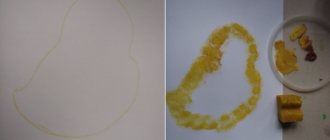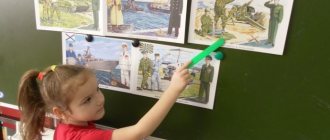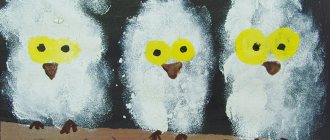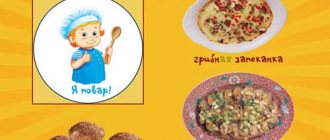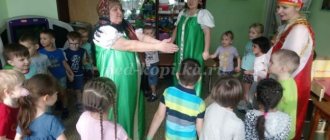Notes on drawing in the middle group “Teddy Bear”
Goal : to make children want to draw a bear using a stencil (outline), learn to paint along the contour using the “poke” method, consolidate knowledge of color (brown), and instill interest in drawing in different ways.
Materials: a sample of a finished drawing of a bear, an outline of a bear on a landscape sheet, a toy - a large brown bear, stencils, bristle brushes No. 4, thin soft brushes, a simple pencil, gouache (brown, black), napkins.
Progress of the lesson:
1. Organizational moment, problematic situation.
- Guys, it seems like someone is crying, can you hear it in the doll corner?
-Who is crying here? (Bear). Yes, this is Mishka the clubfooted one.
- How did you end up here, Mishka, and why are you crying? (The teacher voices the toy.)
- I came to you from the forest. Winter will come soon and I need to go to bed in the den.
“And why did this upset you so much?” After all, all bears sleep in their dens in winter. They feel warm and cozy there in winter.
- Yes it is. I already wanted to lie down in my den for the whole winter, but I remembered that I have no friends, I am so alone. And I felt very, very sad (crying).
- Don't cry, Mishka! You are so beautiful, fluffy, shaggy, calm down (Bear is crying).
- Oh, guys, what should we do? How can we cheer up Mishka? We need to help him find friends. But how? (Children's answers.)
- Can you draw it?
- Calm down, Mishka, don’t be sad, we will help you find friends as beautiful as you.
- Let's go to the tables (everything you need is there).
I have a friend in my hands for our Teddy Bear (show a sample and turn to the toy).
- Look, Mishka, you will have many such beautiful and kind friends.
2. Main part.
— Today we will draw a bear using a stencil. You have stencils of bears on your tables, they are all different: some have a bear standing, some have a bear dancing, some have a bear doing exercises. We will draw different friends for Mishka. To do this, you need to put the stencil on a sheet of paper and trace along the outline with a pencil.
- First, take the stencil in your hand and trace it with your finger. Like this. And then we will color the Bear, and we will do it in a new way. To depict the bear as fluffy, we will use a bristle brush. The brush will work in a special way: it will jump up and down. Take the brushes in your hands and try them without paint (show how the brush will work).
- Well done, you are doing everything right! We start coloring from the head. Look, I'm picking up paint. What color paint do we need to paint the bear? (Brown.)
— I pick up some brown paint and start drawing along the contour. I will go around the entire outline using the “poke” method, then I will paint over the entire bear using the same method. My brush is jumping up and down. The result was a beautiful, fluffy bear. But what did I forget to draw? (Eyes, mouth, nose.) To draw the eyes, mouth, nose, I will take a thin brush, dip it in black paint and paint with the end of the brush. What is my bear's mood?
3. Physical education minute: “Two bears were sitting…”
4. Independent activity of children.
- And now you will each draw your own bear. What kind of bears will you have - happy or sad?
5. Summing up.
Analysis: (I take a toy) Bear, look how many friends you have now! The kids tried so hard to help you. Now you can sleep peacefully in your den.
- Thank you, guys, I like this funny little bear, and this funny one, and I really like them all and now I have a lot of friends! Hooray! Goodbye!
- But before you leave, play with us (the game “Bear-toed Bear”).
- Thank you for staying with us to play. And now it's time for you to go into the forest, goodbye.
The polar bear is a large predator of the north. Photo, description, habitat, offspring.
Currently, the largest mammal on our planet is the polar bear.
It is also called white. This predatory animal is a relative of the brown bear.
Article content:
General indicators
The polar bear is a predator.
An adult animal reaches three meters in length and can weigh about a ton. On average, the weight of a male is 500-800 kg with a length of 2-2.5 meters.
Female individuals are more modest in size. They usually weigh no more than 250 kg. The largest individuals inhabit the area near the Berengov Sea. The smallest specimens live on the islands of the Spitsbergen archipelago.
Polar bears are characterized by having a long neck and a flat head. The fur color can be either white or yellowish. The skin is black.
The animal's fur provides it with high thermal insulation protection due to the ability of the hairs to transmit exclusively ultraviolet rays.
There are hairs on the soles of the paws that prevent slipping. Between the fingers there is a swimming membrane. The bear has large and sharp claws that help it get food.
Where do bears live?
Polar bears prefer to live on the northern shores and borders of warm northern currents.
This animal lives mainly on the shores of the island of Greenland, the islands of Spitsbergen, on some lands in the Barents Sea, on the islands of Vaigach, Kolguev and Medvezhiy, as well as near the Kara Sea.
Also, many individuals of this species live off the coast of the Laptev Sea, the Chukchi Sea and the East Siberian Sea. The favorite habitat of polar bears is the coastal part of the Arctic Ocean.
During pregnancy, females look for a secluded place, wintering in dens. To do this, they choose their main habitats: northern Greenland, small islands of the Kara Sea, the Spitsbergen archipelago, the northern coast of Taimyr Island and other small islands and lands of the Barents Sea.
Dens are also found on the ice of Beaufort. Sometimes in early spring, female bears can move towards the Scandinavian countries, Kamchatka and the Gulf of Anadyr. On ice floes, animals can get into the Sea of Okhotsk and the Sea of Japan.
Diet
Polar bears see and hear very well, and also have a sensitive sense of smell, so they can easily sense prey, even if it is several kilometers away.
The nutrition of an animal depends on its characteristics, as well as on its environment and habitat. Individuals of this species live in harsh polar winter conditions and are well adapted to this. They are very good swimmers and can stay in cold water for a long time.
For these reasons, the objects of their hunt are often marine life, such as walruses or sea urchins. Their diet also includes chicks, eggs, young and defenseless animals, as well as carcasses of animals and fish washed ashore.
Mouse and bear. Drawing with gouache paints Video
Olga Pavelyeva
Mouse and bear. Drawing with gouache paints Video
Drawing with gouache paints (artistic and aesthetic development)
.
Goal: to stimulate empathy about the bear and the mouse ; implementation of independent visual activities.
To begin with, we got acquainted with the Latvian fairy tale “Forest Bear and the Naughty Mouse .” It just seemed boring to me to read, so we decided to watch a video reading of this fairy tale with illustrations.
drawing illustrations difficult for this age; only a few of them turned 5 years old.
Therefore, we decided to color ready-made coloring illustrations from this fairy tale , but we had a problem - we didn’t have the necessary colors. As it turned out, the mouse should be gray , and the bear should be brown.
And here the most interesting part began - experimenting with gouache paints to obtain different color shades: adding white paint to black to obtain gray. Mixing red and green to make brown.
Of course, we are not artists, but the colors of the mice and bears turned out very beautiful and similar to real ones.
And of course, once again a lot of pleasure and satisfaction with my work. Everyone here will probably understand my feelings and joy from the work of their children.
Thank you for your attention!
Photo report on experimenting with water, objects and gouache paints. Autumn time has come, it is raining outside, which means that children can have an exciting activity: experimenting with substances.
Abstract “The Forest Bear and the Naughty Mouse” based on the Latvian fairy tale Objectives: · social and communicative development: o enrich children’s understanding of the emotions of joy and anger (anger) through familiarity.
Master class for parents “Painting with acrylic paints on fabric” Performed by: Kosheleva A.D., Argatyuk E.V. MBDOU “Aurinko”, Kostomuksha Purpose: to introduce parents to non-traditional drawing techniques in activities.
Unconventional drawing techniques. Summary of the lesson “Drawing a watermelon with magic colors” Methodological development of educational activities with children. Educator: Belevtsova Marina Petrovna “Non-traditional drawing techniques.”
Presentation of the fairy tale “Why is the mouse small?” I would like to present to your attention a presentation for the Yukaghir fairy tale “Why is the mouse small?” Where national costumes are clearly presented.
Drawing with “Herringbone” paints, second junior group content: 1. Teach children to draw an object consisting of vertical and oblique lines, to draw straight lines (short, long); learn. Drawing with “Golden Autumn” paints. Photo report. Hello, dear colleagues and guests of my page! So the bright, golden autumn has arrived. I want to tell you how I let the girls down.
Source
On the topic: methodological developments, presentations and notes
Summary of an open lesson on drawing in a non-traditional way (poke drawing + emerging drawing) middle group “Animals of our zoo.” compiled by Kuznetsova Svetlana Vladimirovna Put.
Program content: Introduce children to a new type of non-traditional drawing technique “imprint, imprint with leaves” Create conditions for artistic experimentation: show the possibility.
Introducing middle preschool children to a new, non-traditional drawing technique (drawing with foam rubber).
Goal: To introduce children to a new technique for obtaining images: prints with half an apple. Tasks:1. Give children knowledge about the method of applying paint to the cut of an apple; press half of the apple against the apple.
Lesson summary using an unconventional method of drawing (pointillism).
Teaching children how to draw a bear with a simple pencil and the poking method, conveying the size and proportions of body parts.
On the topic: methodological developments, presentations and notes
in this educational field of Artistic creativity, section: Drawing, non-traditional drawing technology and information technology are used.
- Consolidate knowledge of A. Barto’s poem “Ball”; - Learn to pronounce together the words of the game “My cheerful, ringing ball”; - Continue learning to paint over the outline of a drawing using a piece of foam sponge;-.
The presented material can be useful to teachers in developing creative abilities in preschoolers through unconventional drawing, developing aesthetic perception, and a sense of composition.
Goal: - To consolidate knowledge of A. Barto’s poem “Ball”; - To learn to pronounce together the words of the game “My cheerful, ringing ball”; - To continue to learn how to paint over the outline of a drawing with help.
Introducing children to unconventional drawing techniques: crumpled paper and fingers.
This lesson is conducted with children of the 2nd junior group.
Source
Brown bear, Brown bear, what do you see? print version
Title: Brown bear, brown bear, what do you see?
Author: Bill Martin Illustrator: Eric Carle Publisher: Mijade Language: English Resource type: book Topics: animals, colors, question form Ages: 4-8 years
Brown bear, brown bear, what do you see? This is a classic of children's literature.
Bill Martin's rhythmic writing speaks directly to young children, and Eric Carle's stunning illustrations keep kids excited for reading after reading. It's a children's picture book in which animals, including a brown bear, a red bird, a white dog, a yellow duck, and a teacher, cross the pages, introducing each other as they go.
Culture and vocabulary:
- animals: bear, bird, duck, horse, frog, cat, dog, sheep, goldfish
- colors: brown, red, yellow, blue, green, purple, white, black, gold
Language structures:
- What do you see?
- I see + adjective + animal + looking at me.
Grammar:
- position of adjectives (before a noun in English)
- subject and object pronouns: we / us; I/I
- irregular plural nouns: child / children
Phonology:
- and [i:] (goldfish/green/sheep)
- drop in intonation to a question for which there is no answer “yes” or “no” (What do you see?).
♦ ♦ ♦ ♦ ♦ ♦ ♦ ♦ ♦ ♦ ♦ ♦
Printable activities "Brown bear, what do you see?"
Free download:



